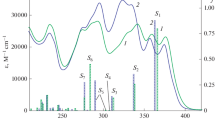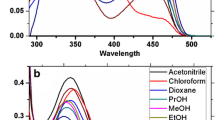Abstract
The structures of isomeric 2-and 4-azidostyrylquinolines and their protonated forms in the ground (S 0) and the lowest excited singlet (S 1) states were calculated by the PM3 semiempirical method and the density functional theory (DFT) using the B3LYP/6-31G* basis set. It was shown that the σ *NN molecular orbital, which is localized on the azide group and is antibonding for the N-N2 bond, is populated in the S1 state of these azides in both neutral and protonated forms. Based on this result, it was assumed that the test azides would be photoactive in both forms, i.e., would have a photodissociation quantum yield of φ > 0.1. The calculation of absorption spectra by the TD B3LYP/6-31G* method showed that the long-wavelength absorption bands of the protonated forms are shifted to visible spectral region, thus suggesting that azidostyrylquinolines in the protonated form will be sensitive to visible light.
Similar content being viewed by others
References
Knorre, D.G. and Godovikova, T.S., FEBS Lett., 1998, vol. 433, nos. 1–2, p. 9.
Wooddell, C.I. and Burgess, R.R., Biochemistry, 2000, vol. 39, no. 44, p. 13405.
Dorman, G., Top. Curr. Chem., 2001, vol. 211, p. 169.
Gritsan, N.P. and Platz, M.S., Adv. Phys. Org. Chem., 2001, vol. 36, p. 255.
Dobrikov, M.I., Gaidamakov, S.A., Shishkin, G.V., and Vlasov, V.V., Bioorg. Khim., 1998, vol. 24, no. 11, p. 831.
Pandurangi, R.S., Kuntz, R.R., and Volkert, W.A., Appl. Radiat. Isot., 1995, vol. 46, no. 4, p. 233.
Gritsan, N.P., Koshkin, A.A., Denisov, A.Yu., Markushin, Yu.Ya., Cherepanova, E.V., and Lebedev, A.V., J. Photochem. Photobiol., B, 1997, vol. 37, p. 40.
Gordon, P.F. and Gregorym, P., Organic Chemistry in Color, Berlin: Springer, 1983.
Budyka, M.F. and Oshkin, I.V., Khim. Vys. Energ., 2005, vol. 39, no. 4, p. 259 [High Energy Chem., 2005, vol. 39, no. 4, p. 216].
Budyka, M.F. and Oshkin, I.V., J.Mol.Struct. (Theochem), 2006, vol. 759, p. 137.
Budyka, M.F., Zyubina, T.S., and Kantor, M.M., Zh. Fiz. Khim., 2000, vol. 74, no. 6, p. 1115.
Galiazzo, G., Bortolus, P., and Gennari, G., Gazz. Chim. Ital., 1990, vol. 120, p. 581.
Stewart, J.J.P., J. Comput. Chem., 1989, vol. 10, p. 208, 221.
Gaussian 03, Revision B.02, Frisch M. J., Trucks G. W., Schlegel H. B., et al., Pittsburg: Gaussian Inc., 2003.
Mazzucato, U. and Momicchioli, F., Chem. Rev., 1991, vol. 91, no. 8, p. 1679.
Wang, S.L. and Ho, T.I., J. Photochem. Photobiol., A, 2000, vol. 135, p. 119.
Budyka, M.F., Biktimirova, N.V., Gavrishova, T.N, Khim. Vys. Energ., 2007, vol. 41, no. 2, p. 30 [High Energy Chem., 2007, vol. 41, no. 2, p. 30].
Author information
Authors and Affiliations
Additional information
Original Russian Text © M.F. Budyka, 2007, published in Khimiya Vysokikh Energii, 2007, Vol. 41, No. 2, pp. 108–114.
Rights and permissions
About this article
Cite this article
Budyka, M.F. Photochemistry of azidostyrylquinolines: 1. Quantum-chemical study of the structure in the ground and the lower excited singlet states. High Energy Chem 41, 77–83 (2007). https://doi.org/10.1134/S0018143907020051
Received:
Issue Date:
DOI: https://doi.org/10.1134/S0018143907020051




